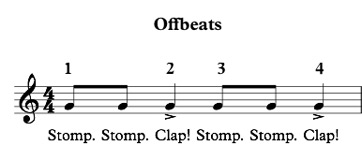Rhythmic processes are omnipresent in people’s lives. For example, the heart is the center of each person’s life, and each person’s heart beats with a unique rhythm that dictates the pace of their life (“Rhythm and Transcultural Poetics”). As a result, rhythm is a natural component of one’s life, so it would stand to reason that the rhythm people find in the music they listen to plays a powerful and sometimes subconscious role in their experience of the music.
Queen took this underlying effect of rhythm and applied it to their songwriting in their simplistic compositions over the years. “We Will Rock You” marks a turning point for the band in their efforts to bring audience members together with an almost experimental dive into minimal texture to create a song with as few instruments as possible to create the most connected community. The entire premise of the composition lies around a rhythmic backing with Freddie Mercury singing the lyrics (“We Will Rock You”). Essentially there are two instruments in this song: Mercury, who provides the vocals; and the audience, who provides the rhythm and percussion for the song. The first element pertaining to the rhythm of the song to analyze is the standalone concept of simply incorporating the audience into the song. There has always been an age old tradition of the audience clapping along with the music, but now, the audience has become an integral part of the music, effectively making them an integral part of the band itself. Without the audience, the song has minimal percussion and consequently, minimal backbone. In this way, Queen creates a “shared performance” with its audience. With this song, the band members are not the only people performing, now the audience gets a chance to perform along with the band and metaphorically share the stage generating a sense of community between the audience and the band.
Following the analysis of the shared performance, the thin texture is the next thing that lends itself to the community theme, specifically the binary instrumentation. Because the performance of the song only includes the audience and Freddie Mercury, the audience can better understand that they have nearly an equal part in the creation of the song. This is to say that the song would not sound full with only Mercury’s vocals. However, one could say that the song would still remain almost full if only the audience was performing. This is to say that the rhythm of the people is the foundation of the song which it is built upon. If the top of a building is taken away, the foundation still remains. If the foundation of a building is taken away, the building has no structural integrity, and is likely to topple. In essence, this binary quality to the music places the song almost entirely in the ownership of the audience. One audience member alone cannot create this music, but thousands of people marching to the same beat in unison creates a powerful and grounded backbone to the song that is only as strong as the number of people marching beside each other.
The other general element that is an important factor in the power of the connection between the audience and the band is that of Freddie Mercury. Freddie Mercury was, and still is, the face of the band and was seen as a larger-than-life figure in music. He was seen as almost a mythic person who embodied the qualities of the stereotypical rock star (Pop Expresso). With this song, Mercury is placing the stardom and power that he has in the hands of the average person. The audience having an equal share in the performance of the song as someone who is idolized as much as Mercury strengthens the experience of contribution that lends itself to the sense of community between audience members.

The final aspect to analyze is the actual rhythm that the audience is performing. The step-step-clap rhythm displayed below follows a rhythm of 1&2 3&4 in a measure of the song, or a repeated sequence of two eighth notes followed by a quarter note.

The final aspect to analyze is the actual rhythm that the audience is performing. The step-step-clap follows a rhythm of 1&2 3&4 in a measure of the song, or a repeated sequence of two eighth notes followed by a quarter note. This rhythm’s strength is its simplicity. The uncomplicated rhythm that the song contains is a rhythm that is almost tribal in nature. A marching quality can be found and felt within both the motion of the rhythm and the sound it creates. This tribal march characteristic of the song represents the physical acknowledgement between the people in the audience. With this movement, an audience member can look around and feel lifted up, because the people around them are simultaneously moving in the same way. The sound that this movement creates is of a similar tribal quality that is both appealing to nearly every listener, and easy to replicate if they wish to join in. This infectious rhythm grows in power and influence with the number of participants. One person alone cannot create the music, and with every extra participant, the listener finds him or herself being almost persuaded or coaxed into taking part in creating something that is bigger than they are alone. There is a sense of dependency that lies between the audience members that fortifies with each passing measure and strengthens the trust among them surrounding the dedication to the music. There is no half participation, and there is no saboteur. This means that no one person could deter the voice of the many people in the crowd stomping and clapping in unison. The dedication and willful participation that this rhythm evokes is what makes it so strong. This rhythm that is the essence of the song creates a community that is reinforced by its dependency on the people who are a part of that community.